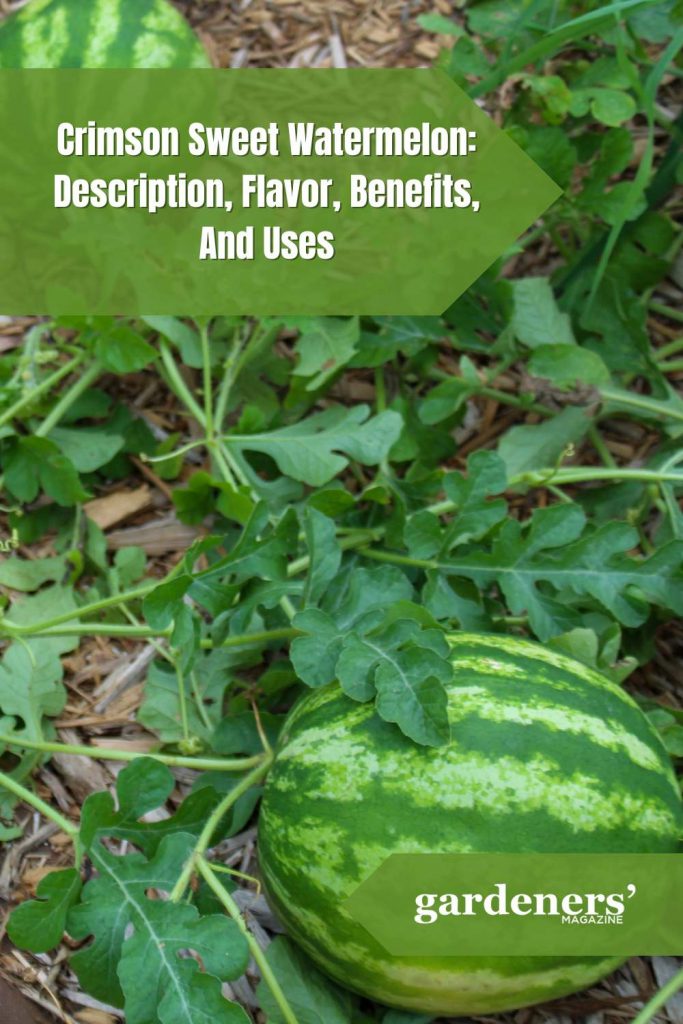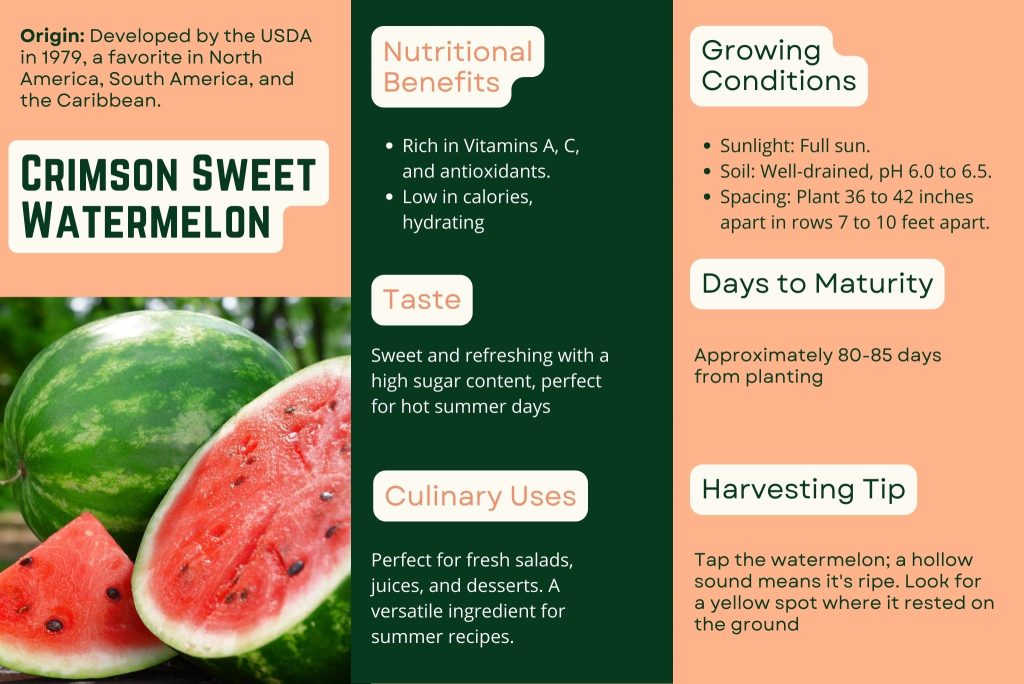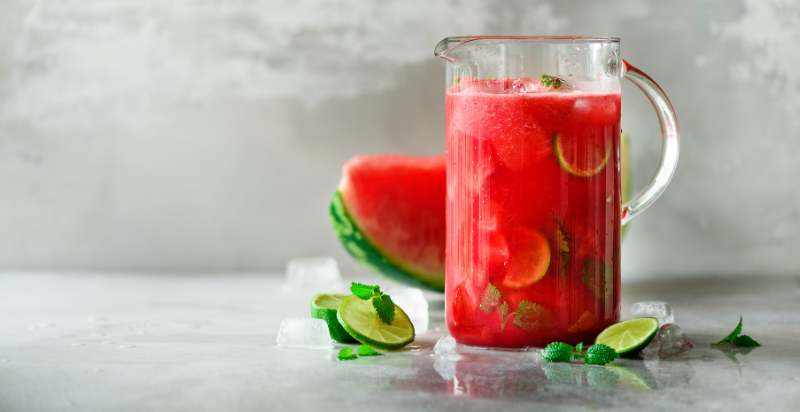Dive into the world of Crimson Sweet Watermelon, a true summer delight that’s as tasty as it is beautiful. It’s a watermelon with striking dark green stripes, hiding a bright red, juicy flesh inside. Crimson sweet watermelon is a favorite for its sweet, refreshing taste that seems just perfect for those hot, lazy afternoons. Developed back in 1979, this variety quickly became a hit in gardens and picnics across North America, South America, and even the Caribbean.
What makes it stand out? Aside from its mouth-watering sweetness and satisfying crunch with every bite, it’s known for its generous size and excellent disease resistance, making it a reliable choice for growers. Whether you’re slicing it up for a quick snack or mixing it into a fruit salad, Crimson Sweet Watermelon brings a burst of summer joy that’s hard to beat. So, let’s get ready to explore everything this wonderful melon has to offer!
Characteristics
Crimson Sweet watermelon is known for its bright red flesh and sweet taste. Its outer rind is typically light green with dark green stripes, and the inner flesh of the fruit contains hundreds of tiny seeds. The pulp inside the watermelon is deep red and packed with a sweet flavor.

History and Origin
Let’s take a little trip back to 1979, a year that marked a sweet revolution in the world of watermelons. That’s when the Crimson Sweet first made its grand entrance, thanks to the hard work of the USDA. They were on a mission to create a watermelon that wasn’t just deliciously sweet but also tough against the common foes of melons – diseases like fusarium wilt and anthracnose.
The result? A watermelon that quickly became a hit in gardens and farms far and wide. The Crimson Sweet wasn’t just any melon. It was a standout with its deep green stripes and vibrant red, juicy interior, packed with that perfect sweetness we all crave on a hot summer day. But its appeal wasn’t just skin deep. This melon was robust, offering peace of mind to those growing it with its resistance to pesky diseases.
Description and Characteristics
The Crimson Sweet Watermelon is a large, round melon that averages about 20-25 pounds and measures approximately 10 to 12 inches in diameter. Its bright red flesh has a slightly yellowish tint, and its sweet taste resembles a honeydew melon. The melon also has a thin, dark green rind that is tough to the touch.

Flavor Profile
The Crimson Sweet Watermelon is characterized by its sweet and juicy taste. Its flesh is a deep red, almost crimson color that can be seen from the outside of the melon. This variety of watermelon has a crisp texture, and when ripe, it will have an intense sweetness that is incomparable to any other type. It has a mild, slightly tart flavor, making it the perfect ingredient for various dishes.
Growing Conditions
Crimson Sweet watermelon can be grown in full sun, although it requires well-drained soil with a pH range of 6.0 to 6.5. The plant needs at least an inch of water every week during the growing season, although rainfall frequently meets this amount. The soil can retain moisture by receiving organic matter by adding compost or old manure. Plan for the vines to occupy a sizable portion of your garden because they grow swiftly and require a lot of room to spread out.
Nutritional Benefits
Crimson sweet watermelon is a nutritious fruit that offers many health benefits. It’s low in calories and rich in vitamins, minerals, and antioxidants. A cup of cubed watermelon contains only 48 calories while providing important nutrients like vitamin C, magnesium, potassium, copper, and manganese.
Planting Instructions
Planting Crimson Sweet Watermelon is a fun garden project that brings sweet rewards. Here’s how to do it, step by step.
- Find the Perfect Spot: Watermelons love the sun, so choose a sunny part of your garden. They need about 6 to 8 hours of sunlight daily to thrive.
- Soil Matters: These melons prefer well-drained, fertile soil. Add some compost or manure to enrich your soil before planting. A pH between 6 and 6.8 is just right.
- Sowing Seeds: Wait until the threat of frost is gone and the soil is warm. Plant seeds about an inch deep in the ground. Space them out about 2 feet apart in rows, with rows about 4 to 6 feet apart. This gives them room to spread.
- Water Wisely: Keep the soil moist, especially during the early stages of growth and when the fruits start to form. But be careful not to overwater.
- Transplanting Seedlings: If you started your seeds indoors, move them outside after the last frost. Make sure to harden them off first to get them used to outdoor conditions.
With a little patience and care, you’ll see your Crimson Sweet Watermelons start to grow, promising delicious fruits for later in the summer.
Growth Stages and Days to Maturity
Watching a Crimson Sweet Watermelon grow is like following a slow, rewarding journey. Let’s break it down into stages, so you know what to expect from seed to harvest.
- Germination: This is where it all begins. After planting your seeds, they’ll need about 7-10 days to sprout, given the soil is warm enough. You’ll see little green shoots pushing through the soil, a sure sign your watermelon journey is underway.
- Seedling Stage: Those shoots will grow into small plants with a couple of true leaves. This stage is crucial for establishing a strong foundation for future growth. It lasts about 3-4 weeks.
- Vining Stage: Next comes the fun part. Your plants will start to vine, spreading out across the ground. This is when they’re getting ready to flower and eventually bear fruit. This stage can last a good while, as the vines get bigger and start to flower.
- Flowering and Fruit Set: After about 35-45 days from planting, you’ll notice flowers. These will turn into tiny watermelons before you know it.
- Fruit Growth to Maturity: Now, patience is key. It takes about 80-85 days from planting for Crimson Sweet Watermelons to reach maturity. You’ll know they’re ready when they sound hollow when tapped and have a creamy yellow spot where they rest on the ground.
From tiny seeds to juicy watermelons, each stage brings its own excitement and challenges. Just give them love, water, and sunshine, and they’ll do the rest.
Care and Maintenance
Caring for Crimson Sweet Watermelon plants is pretty straightforward, but there are a few tips to keep in mind to help them thrive.
Watering: These plants love water, especially when they’re young and when the fruits are growing. Aim to keep the soil consistently moist but not soggy. A deep watering once a week should do the trick, but feel free to adjust based on the weather. Hotter days might call for a bit more water.
Fertilizing: A little food goes a long way. Start with a balanced fertilizer when you plant them, and then give them a boost with a high-potassium fertilizer once they start flowering and setting fruit. This helps develop those big, juicy watermelons we all love.
Pest Management: Keep an eye out for common pests like aphids and cucumber beetles. They’re not just annoying; they can harm your plants. A good spray of water can knock aphids off, and floating row covers can help keep beetles away. Also, be on the lookout for diseases like powdery mildew. Keeping the leaves dry and ensuring good air circulation can help prevent it.
When to Pick and Harvest
Picking the perfect Crimson Sweet Watermelon is all about timing. You want that sweet, juicy taste to be just right. So, how do you know when it’s time to harvest? Here are a few signs to look out for.
First, check the color on the bottom. When a watermelon is ripe, the spot where it rests on the ground turns from white to a creamy yellow. It’s like the melon’s way of saying, “I’m ready!”
Next, give it a knock. A ripe Crimson Sweet will have a deep, hollow sound, kind of like thumping a drum. If it sounds more like a thud, it might need a bit more time.
Also, take a look at the tendril closest to the fruit. When it’s brown and dried up, that’s a good indicator your watermelon is ripe. If it’s still green, your melon is probably not quite ready yet.
Lastly, the skin of the watermelon becomes tougher when it’s ripe, resisting a bit when you try to scratch it.
Spacing and Yield Per Plant
When it comes to growing Crimson Sweet Watermelons, giving them enough room to sprawl out is key. These plants are not shy; they like their space. For healthy growth, you’ll want to plant them about 3 to 4 feet apart in rows. And those rows? Keep them a good 6 to 8 feet apart. This might seem like a lot, but trust me, those vines will thank you by spreading out and soaking up the sun, leading to more and bigger watermelons.
Now, let’s talk about what you can expect to harvest from each plant. On average, a well-cared-for Crimson Sweet Watermelon plant can yield about 2 to 3 large melons. These aren’t just any melons, though. We’re talking about watermelons that can weigh anywhere from 20 to 25 pounds each when they’re ripe and ready.
So, with the right spacing and a little TLC, each of your Crimson Sweet plants can become a mini watermelon factory. Just imagine the delicious, juicy watermelons you’ll have, perfect for summer picnics or a refreshing snack. Give them room to grow, and they’ll reward you generously.
Where are Crimson Sweet Watermelon Grown in the US?
Crimson Sweet Watermelon is typically grown in the warmer climates of the United States, such as California, Arizona, and Florida. It is also commonly grown in parts of Mexico and South America. The melons are usually harvested by hand when they reach full size and maturity.
During harvest time, workers will go through fields, pick out the ripe watermelons, and place them into baskets. Once collected, the melons are washed and shipped to stores or markets for sale. Farmers may sometimes use a mechanical harvesting machine that can pick up multiple watermelons at once. This method is faster, but it can also bruise the skin of the melon, resulting in less-than-perfect fruit.
Where can the Best Quality Crimson Sweet Watermelon be found?
The best quality Crimson Sweet Watermelon can be found at farmer’s markets, grocery stores, and specialty produce shops. It is important to look for melons free from bruises or cuts in the skin as these defects could compromise When purchasing, make sure to pick a melon with a smooth rind that has no cracks, cuts, spots, or discoloration on the surface. Additionally, look for melons that feel heavy for their size and have a bright yellow spot where they rest on the ground.
Comparison with Other Varieties
When you’re picking out watermelon seeds, you might find yourself wondering about the differences between varieties like Crimson Sweet and Sugar Baby. Both are fantastic, but they’ve got their own unique perks.
Crimson Sweet is the big guy on the block. These watermelons are known for their size, often weighing in at 20 to 25 pounds. They’ve got beautiful dark green stripes and a sweet, juicy red flesh that’s hard to beat. They need a bit of room to grow, thanks to their sprawling vines, and they thrive in warm, sunny spots with well-drained soil.
On the flip side, Sugar Baby is the more compact cousin. These melons are smaller, usually weighing around 8 to 10 pounds, making them a great choice if you’re tight on space. They have a dark green, almost black rind, and their flesh is just as sweet and delicious as the Crimson Sweet. Sugar Babies can fit into smaller gardens or even large containers, making them versatile for different growing conditions.
Both varieties bring the sweet, refreshing taste we love in watermelons, but your choice might come down to how much space you have and whether you’re up for wrestling with a 25-pounder or prefer something a bit more manageable.
Uses in Culinary and Recipes
Crimson Sweet Watermelon isn’t just for slicing and eating on a hot summer day (though that’s pretty great, too). This juicy, sweet melon can be the star in a variety of dishes, from refreshing salads to cool drinks and even some unexpected desserts.
Crimson Sweet Watermelons can be used in a variety of recipes featuring fruits and vegetables. They make a delicious addition to summer salads with other seasonal produce such as cucumbers, tomatoes, bell peppers, and onions.
Here are a few quick recipes:
Salad: Cube up some Crimson Sweet, toss it with feta cheese, fresh mint, and a drizzle of balsamic glaze. It’s a combo that’ll make your taste buds sing.
Slushie: For a real summer treat, blend up some watermelon chunks with ice, a squeeze of lime, and a touch of sugar for a slushie that’ll cool you down in no time.
Watermelon Sorbet: It’s as easy as blending watermelon, freezing it, and giving it another quick blend before serving. Or, for a fun twist, dice it up and mix it into a fruit salsa. Serve it over grilled chicken or fish, and watch everyone ask for seconds.
The sweet watermelon also pairs nicely with chilli-based dishes or tacos that include black beans and corn. Another great way to use Crimson Sweet Watermelons is to make a refreshing salsa that has diced mango, onion, bell pepper, and cilantro. They can also be used as a component in fruit kabobs with other summer fruits like strawberries, pineapple, and cantaloupe.
No matter how you use it, Crimson Sweet Watermelon is sure to bring a bright burst of flavor to any dish.

Conclusion
So, there you have it, everything you need to know about growing your own Crimson Sweet Watermelon. It’s a journey worth taking, from planting those first seeds to enjoying the juicy, sweet fruits of your labor. Whether you’ve got a sprawling garden or just a little patch of sunshine, giving these watermelons a try could add a whole lot of flavor to your summer.
And remember, to share your stories, your successes, and even those oops moments. Got a tip that made your watermelons the talk of the town? Or maybe a recipe that turns them into a mouthwatering treat? Share away! Let’s keep the conversation going and help each other grow the sweetest, most delicious watermelons out there. Happy gardening, and here’s to a summer filled with the freshest, sweetest Crimson Sweets you’ve ever tasted!
Frequently Asked Questions
What’s the scientific name for Crimson Sweet Watermelon?
It’s called Citrullus lunatus. This puts it in the same family as other melons and gourds.
How do I deal with common pests that attack watermelons?
Keep an eye out for aphids and cucumber beetles. A gentle spray of water can knock aphids off your plants. For beetles, try using floating row covers to protect your plants. Always check the underside of leaves and remove any pests you find by hand if possible.
What’s the secret to getting the best flavor from my Crimson Sweet Watermelon?
The key is sunlight and warmth. Make sure your watermelons get plenty of sunshine, at least 6 to 8 hours a day. Water them regularly, but avoid overwatering. Letting the soil dry out a bit between watering encourages deeper root growth. Pick your watermelons when they’re fully ripe for the sweetest taste – look for the yellow spot on the bottom and listen for a hollow sound when you tap them.
- Everything You Wanted to Know About Red Tamarillos - June 2, 2025
- A Guide to Tulips: Everything You Need to Know & More… - June 2, 2025
- Guanabana: Description, Flavor, Benefits, And Uses - May 27, 2025

6 thoughts on “Crimson Sweet Watermelon: Description, Flavor, Benefits, And Uses”
Comments are closed.